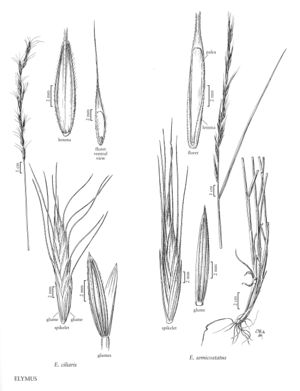Elymus semicostatus
Plants cespitose, not rhizomatous. Culms 45-135 cm, erect or geniculately ascending, glabrous. Sheaths glabrous or villous; auricles to 1.5 mm; ligules 0.5-1.5 mm, truncate; blades 15-30 cm long, 4-12 mm wide, sometimes villous, adaxial surfaces smooth or scabrous, primary and secondary-veins alternating. Spikes 8-30 cm long, 1-2 cm wide including the awns, 0.5-1 cm wide excluding the awns, erect or nodding, usually with 1 spikelet per node, sometimes with 2 spikelets at the lower nodes; internodes 10-20 mm long, about 0.8 mm wide, scabrous on the margins and on the surfaces, marginal prickles larger than those on the surfaces, hirtellous just below the spikelets. Spikelets 16-30 mm, loosely appressed, with 6-8 florets; rachilla internodes about 0.8 mm, strigose, hairs to about 0.3 mm; disarticulation above the glumes, beneath each floret. Glumes subequal, 10-18 mm long, 1.1-2 mm wide, elliptic-lanceolate, green, not keeled, 5-7-veined, veins more or less equally prominent, scabrous, apices acute to acuminate; lemmas 10-14 mm, scabrous or puberulent dorsally, awned, awns (4) 12-18 mm, straight; paleas 3/4 as long as to slightly shorter than the lemmas, keels outwardly curved below the apices, apices 0.3-0.7 mm wide, truncate; anthers 3-6 mm. 2n = 28.
Discussion
Elymus semicostatus is native to central Asia, from Afghanistan through Pakistan to northeastern India (Sikkim). Reports of its presence in the Flora region appear to be based on misidentifications.
Selected References
None.
Lower Taxa
"decumbent" is not a number.
